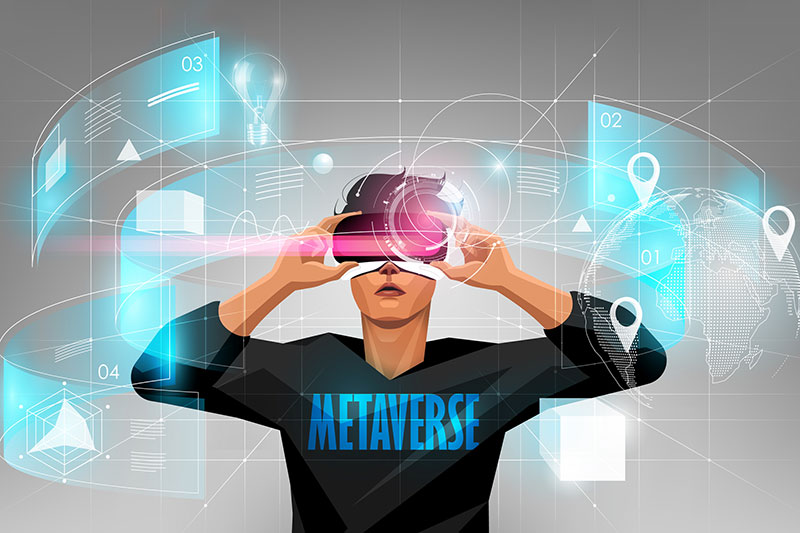When COVID sent employees to work from home, Accenture, like most companies, faced the challenge of how to onboard new employees when you can’t bring them to the office. The consulting giant’s solution was to bring them to the Nth Floor for orientation.
 The Nth Floor is a virtual workspace where colleagues can collaborate with the assistance of a VR headset as if they were all in the same room together. “We shipped the device to new hires and then did training sessions on the Nth Floor,” Yusuf Tayob, group chief executive of operations, said in an interview. “I have my Oculus device sitting across from me on my desk, and I can go to the Nth floor now, and there will be people collaborating on projects.”
The Nth Floor is a virtual workspace where colleagues can collaborate with the assistance of a VR headset as if they were all in the same room together. “We shipped the device to new hires and then did training sessions on the Nth Floor,” Yusuf Tayob, group chief executive of operations, said in an interview. “I have my Oculus device sitting across from me on my desk, and I can go to the Nth floor now, and there will be people collaborating on projects.”
Without question, there is interest on the part of business – think Facebook’s name change to Meta – and on the part of supply chain managers. An article on the Metaverse by Roit Kathiala, a retail fast-fashion supply chain leader, was the most widely-read article on SCMR.com the month it was published.
That’s an anecdotal data point. However, Meet me in the Metaverse, Accenture’s Technology Vision 2022 survey, highlights two key points. One is that 78% of CSCO’s have successfully adapted to pandemic-related disruption, and that “newer technologies – like the metaverse - are at the epicenter of CSCO leadership decisions.”
Second is that 48% of CSCO’s “believe the metaverse will have a transformational impact on their organizations, with 25% believing it will be breakthrough or transformational.” Nearly two-thirds “believe programming the physical environment will emerge as a competitive differentiation in their industry.”
The results did not come as a surprise to Tayob, who said that Accenture has been in the Meta business – however they define it – for a decade. The company has 600 patent filings related to the Metaverse. That said, he recognizes that for consumers and business, “it’s a new conversation. I liken it to the Cloud. Five years ago, people thought of the Cloud as new, but Accenture was doing Software-as-a-Service a decade ago.” He added: “We see this as having a profound affect on our clients across a number of industries, and equally affecting the B2B and B2C spaces.”
Now before you start wearing your kids’ Virtual Reality headset to the office, a note of caution. If you attended the most recent Modex, you could barely walk down an aisle without tripping over a robot vendor, which might lead you to believe that yours is the only company in the world not already using robots. And, indeed, a robot revolution is probably coming. However, I’m reminded that Kiva, perhaps the first example of an autonomous mobile robot designed for the warehouse, was founded in 2003 and exhibited for the first time at a trade event in 2007 – it’s taken nearly 20 years to get wherever we are in terms of the adoption of robots. And where is that? In a recent survey of the Peerless Media audience, 52% of respondents said they are either currently using or are investigating the use of robots for their warehouse and DC operations; 48% said they have no plans.
Tayob envisions new ways to work and interact with supply chain partners that will deliver benefits. “We will be able to bring together and interact with trading partners in disparate locations and provide them with a consistent experience,” he said. “You’ll have the ability to interact with others in real-time and with the data you can provide, like reports from people on the shop floor.”
As an example, in a digital twin, you would have the ability to not just scenario plan by running reports, but to visualize the impact of the changes and adjustments you make to your operations. “You could connect the physical space with supplier data, with publicly-available data like weather data or connect to other digital twins,” he said. “It becomes a much more dynamic environment.”
Still, while the Metaverse may roll out faster than robotics, Tayob expects that it won’t happen overnight, but rather in a continuum. In fact, he sees the evolution of digital twins comprising 5 stages, some of which are happening now.
- Static Twin: In Stage 1, you can model process behavior at a point in time with historical data, what we currently call scenario planning.
- Scenario Twin: In Stage 2, you can model behavior of the supply chain over time for trend analysis.
- Connected Twin: In Stage 3, you will be able to connect your digital twin to other enterprise systems upstream and downstream.
- Integrated Twin: In Stage 4, you will be able to bring in human assets as part of the modeling process and scenario planning.
- Autonomous Twin: In Stage 5, which Tayob called “the art of the possible,” you can synchronize all of the components in the first four stages. It allows you to bring the digital and the physical together.
According to Tayob, there are aspects of the autonomous twin available today, but they aren’t synchronized and connected.
“You probably read in our press release that an overwhelming percentage of executives believe the Metaverse is going to have an affect on their businesses,” he said. “Think about the digital simulation of new product development across the supply chain, the transparency you could have into your suppliers’ operations or the transparency you could provide to customers about your ESG initiatives. There are so many aspects to this.”
SC
MR


Latest Supply Chain News
- Humanoid robots’ place in an intralogistics smart robot strategy
- Tips for CIOs to overcome technology talent acquisition troubles
- There is still work to do to achieve supply chain stability
- Blooming success: The vital role of S&OE in nurturing global supply chains
- Supply chain salaries, job satisfaction on the rise
- More News
Latest Resources

 Explore
Explore
Software & Technology News
- Humanoid robots’ place in an intralogistics smart robot strategy
- Tips for CIOs to overcome technology talent acquisition troubles
- Game on: Rethinking change management for the digital era
- Predicting stockouts: Enhancing FMCG resilience through data-driven insights
- Top Performers Investing in, Benefitting from AI
- Electronics Supply Chain Seeks Balance in 2024
- More Software & Technology
Latest Software & Technology Resources

Subscribe

Supply Chain Management Review delivers the best industry content.

Editors’ Picks




